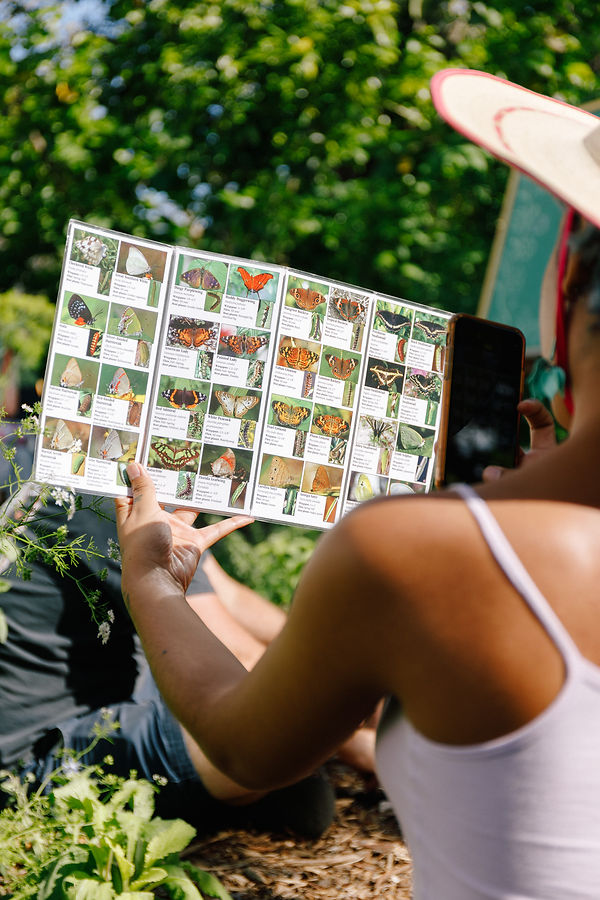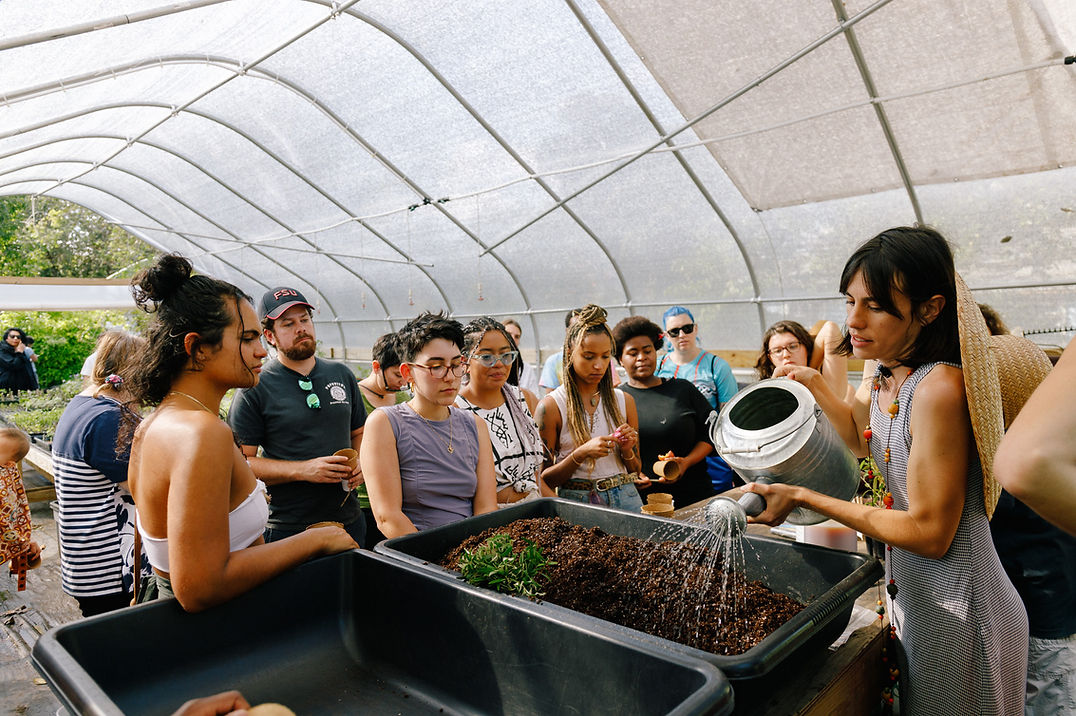
PARK WEST PAPER
MEMORY OF THE LAND
Miami is restoring its memory of the land, returning to what it must. The roosters’ deliberate dance rushing to cross the street in search of feed, the caress of the wind upon colorful flora, the pink bougainvilleas coddled under palm trees, with frequent visits from pollinating bees and butterflies. These wishes have a resonating echo, where more and more people in a vice city are looking to fall in love with the trees, the flowers, heal through herbs, imitate the resilience of roots, and spend time observing and learning from the patient growth of nature.
For many immigrant families from the Global South and Diaspora communities, nature represents a sacred connection, anchored in Indigenous teachings and pre-colonial interpretations of our existence in the natural world. The interwoven dynamic of nature and the land reminds us that we cannot exist in silos; we are always moving as part of a vast and interconnected constellation. The land is within us, and we are within her.
I spoke with some folks that are leading us through this journey back through our ancestral memories and onto a renewed connection to the Earth under our feet.

Gabriela and Ashley, Femme Fairy Garden
“One of my favorite parts about our garden is how each individual has found a sense of happiness that radiates miles away. Neighbors walk by and join in, and it is the closest to freedom I have ever felt,” said Ashley Varela.
Varela is the co-leader of Femme Fairy Garden, a queer-and-POC-activated community garden located in the historic Belafonte Tacolcy Center in Liberty City. This urban oasis’s birth came from a call by local artists and community organizers to create practices that would alleviate the stress produced by their political work. They, however, recognize the irony that returning to the land is in itself political.
Fragrant basil surrounds the pathway leading into Femme Fairy Garden. As I make my way towards garden beds filled with kale, I notice it is growing in abundance this season, balking at its reputation as a luxury super-green. I pass collards, eggplant, cilantro (which stirs memories of home-cooking), and yarrow (a natural cold and flu remedy), as I’m told many of the seedlings were planted at the beginning of the season by children in the youth program, Colors of the City.
The garden approach is open, collaborative, and centered on the idea that tending to the land is not just a political act but one of ease and healing. Gabriela Rosado, co-leader of Femme Fairy Garden, is Puerto Rican and comes from a familial lineage of folks learning from plants.
“We are not from the city,” says Rosado, “and sometimes there’s a lot of internalized shame about that, but the profound level of medicinal and natural knowledge that comes from being from the countryside is invaluable.”
An upcoming project for Femme Fairy Garden will provide gardening internships for formerly incarcerated folks returning to the community. They intend that they will become stewards of the land. Our people are not disposable, and neither is the Earth.

Gabi Serra, Buenezas
Nestled between lush canopies adorned with golden pothos vines and the rushing laughter of young children, I talk with Gabi Serra, a grower from Semillas Cooperative Farm in North Miami. Serra’s journey back to nature started ten years ago as a means of healing and as an outlet from day-in and day-out stressors. “When I first moved to the states from Venezuela, I became so aware of the loss of access to natural public spaces, and it shook me to my core; you know, we take that for granted sometimes.”
As we make our way through the nursery, she points to the array of herbs that grow: fresh indigo—which is used as a blue dye or a liver-detoxifying tea, Vicks Plant for homemade vapor rub to clear nasal and respiratory passages, and Shiso, a popular Japanese violet-colored mint.
The concept behind Buenezas, Gabi’s current project, is to shift the strictly negative connotation of plants classified as “weeds” and invite holistic understanding, context based on local climate, and education on how to relate to these weeds sustainably. “Buenezas” is a play on words that turns the Spanish term for weeds, “malezas” on its head. Sometimes, weeds are just in the wrong place at the wrong time.
Their latest workshop focuses on deepening our love for butterflies’ metamorphosis and learning how butterflies are not merely beautiful but serve a crucial role in maintaining our ecosystem’s equilibrium. As community members sit around the bushes and flowers, a young child grabs his sketchbook and shares his colorful drawings of distinct plants, explaining which was what, while pointing to them directly. It reminds me of the many ways children are more intuitive to the pace of nature than adults, leaning into their curiosity while demonstrating reciprocal respect to their surrounding ecology.
In the spirit of re-defining weeds, Gabi cooked some homemade Spanish needle tamales. Spanish needle is a plant native to Florida, and though considered a weed, blossoms attractive foliage perfect for butterflies and bees. The tamales that were shared among attendees and neighbors are an invitation to unlearn what is not serving us and learn the wisdom that has been stripped from our everyday.


Chantelle, Urban Oasis Project
Biophilia, the social psychology theory that proposes that humans are intrinsically attracted to nature, helps explain the direct relationship between our level of alienation from the natural world and our thirst to reconnect with it.
Chantelle, Daily Operations Manager for Urban Oasis Project, has an intimate and candid perspective of how people’s lives pivot when they are in proximity to greenery. Urban Oasis runs a program, G.I.V.E, where they build free garden beds for low-income families living in food deserts. They believe that having access to plants, gardening, and growing food are fundamental rights that have been stripped from us in just one generational cycle for the sake of corporate profit. These garden beds are not a frivolous idea; they are a step towards getting in touch with ancestral wisdom, a sense of abundance over scarcity, and slowness in an increasingly hectic city. Caring for plants and ensuring their growth forces us to have a heightened sense of awareness and mindfulness.
“For every garden that I have built [last year she built thirty], every family is extremely grateful, and there’s a deep sense of joy,” says Chantelle.
She recalls a conversation she once had with elderly woman from Jamaica, who now lives in Miami Gardens: “When she grew up in the Islands, she would spend leisurely afternoons in markets, gazing through the rainbow-like produce and exchanging with local vendors. Her children have been robbed of these experiences.”
Chantelle, a Caribbean immigrant herself, resonates deeply with this longing, and her understanding of local native plants is impressive. When asked what the best seasonal snack was, she responds quickly, “Chocolate Sapote, which in short, is nature’s chocolate pudding.”
Thinking of all that is healing, bountiful, and delicious—I’m reminded that everything we want, everything we need, and everything we deserve is in the land. Let’s return home. I want to remember what it’s like.
Written by Niki Franco
